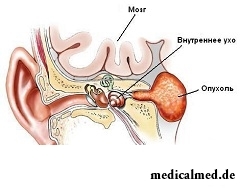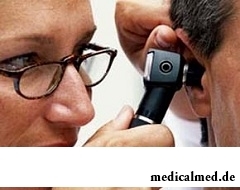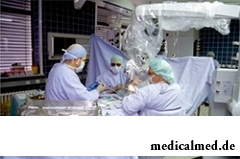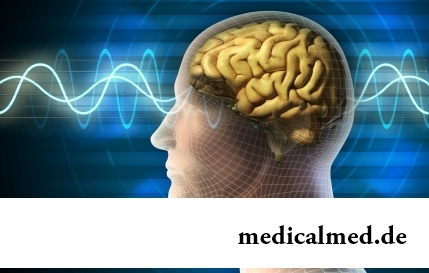





Neurinoma
General characteristic of a disease
 The neurinoma (or a shvannoma) is the benign tumor which is formed in schwannian cells of spinal, cranial and peripheral nerves. Thus, the neurinoma is a new growth in cells which cover nerves. They present themselves roundish, sometimes lobular formations in the form of the capsule. Appear most often in a root of an acoustical nerve (a vestibular portion), progress in a mosto-cerebellar corner (facial and acoustical nerves), is more rare – in a root of the V nerve (maxillary and mandibular, orbital nerves). And extremely seldom neurinoma arise in roots of the glossopalatine and wandering nerves.
The neurinoma (or a shvannoma) is the benign tumor which is formed in schwannian cells of spinal, cranial and peripheral nerves. Thus, the neurinoma is a new growth in cells which cover nerves. They present themselves roundish, sometimes lobular formations in the form of the capsule. Appear most often in a root of an acoustical nerve (a vestibular portion), progress in a mosto-cerebellar corner (facial and acoustical nerves), is more rare – in a root of the V nerve (maxillary and mandibular, orbital nerves). And extremely seldom neurinoma arise in roots of the glossopalatine and wandering nerves.
The percent of a disease of a neurinoma – rather small also makes about 8% of all intracranial new growths and about 20% of all primary spinal educations. People of middle and advanced age are subject to this disease, at the same time women are ill more often. Since the neurinoma is high-quality with slow-growing new growths, it develops into a malignant tumor very seldom.
The following types of a neurinoma are the most widespread:
1. Morton's neurinoma. This benign tumor is formed in a zone of a bottom nerve of foot. In most cases arises in the place of passing of a nerve of the third and fourth fingers of foot, sometimes between the second and third fingers. Generally strikes one foot, it is very rare - both.
2. A neurinoma of an acoustical nerve (carries also the name a vestibular shvannoma). In most cases such tumor arises in a vestibular branch of an acoustical nerve, and its growth continues in a cerebellar and bridge corner. The neurinoma increases in the volume therefore there is pressure upon a cerebellum and a brainstem. The direct contact of education with facial nerves sometimes even affects lower cranial and trigeminal nerves.
Distinguish a unilateral neurinoma of an acoustical nerve (about 95%) and bilateral (5%). The last is usually caused by a neurofibromatosis, and its first manifestations are possible on the second decade of life, unlike unilateral to which, most often, aged people of 40-50 years are subject.
3. Backbone neurinoma. It is caused by a tumor of roots of spinal nerves, and in most cases arises in chest and cervical department, is more rare in lumbar. It is considered the most widespread disease from primary new growths on a spinal cord. Develops as an extramedullary and intradural tumor in schwannian cells.
Neurinoma of roots of a spinal cord can extend through an intervertebral foramen ekstraduralno. Such form of a neurinoma belongs to type of "hourglasses" and is characteristic of cervical department of a backbone. Effects of a neurinoma of a backbone are bone changes which are diagnosed by a usual spondilografiya.
The neurinoma trigeminal and other nerves is a consequence of a tumor of an acoustical nerve, and such look as a sredostreniye neurinoma – tumor subspecies on a backbone.
Neurinoma reasons
Histologically the neurinoma is a result of high-quality reproduction of Schwannian cells (from here and the second name of a disease of Shvannom) which form a myelin cover of nerves and that influences this process – is up to the end not studied.
Neurinoma symptoms
 The first notable symptoms of a neurinoma of an acoustical nerve the ring in ears is considered, about 60% of all patients, and also the decrease in hearing especially noticeable at telephone conversation complain of it. In most cases work of acoustical function changes gradually, but in 10-20% there is an instant decrease in hearing. Damages of a vestibular nerve can be shown at sharp turn of the head or body, at the same time there is an unpleasant feeling of instability or loss of balance. In case education has quite big sizes, hydrocephaly can be shown (liquid accumulation a brain). At the same time, as the accompanying sign is possible scarcely noticeable front paralysis.
The first notable symptoms of a neurinoma of an acoustical nerve the ring in ears is considered, about 60% of all patients, and also the decrease in hearing especially noticeable at telephone conversation complain of it. In most cases work of acoustical function changes gradually, but in 10-20% there is an instant decrease in hearing. Damages of a vestibular nerve can be shown at sharp turn of the head or body, at the same time there is an unpleasant feeling of instability or loss of balance. In case education has quite big sizes, hydrocephaly can be shown (liquid accumulation a brain). At the same time, as the accompanying sign is possible scarcely noticeable front paralysis.
The main symptom of a neurinoma of a backbone is the radicular pain caused by development of a disease in back sensitive roots. Neurinoma of a backbone develop slowly. Therefore the right diagnosis is established only after several years of pains if localization is noticed in wide lumbosacral department. The narrow cervical department allows to reveal a disease at an early stage because signs of pressure upon a spinal cord appear. In the presence of a tumor in a side triangle of a neck and in a supraclavicular zone (which, as a rule, arise in roots of a cervical or brachial plexus) pain in necks or a shoulder girdle is possible.
Because peripheral neurinoma proceed is long and asymptomatically, the tumor is found as hypodermic volume education without painful signs.
Treatment of a neurinoma
Treatment of a neurinoma can take place in several ways, irrespective of the place of formation of a tumor.
1. The conservative method of treatment in this case means purpose of such drugs as: Mannitolum in combination with glucocorticoids, and also control of water and electrolytic balance and a diuresis. Also appoint drugs which improve cerebral circulation.
2. The most widespread method is a surgical removal of a neurinoma.
 This method consists in radical removal. Treatment of a neurinoma at an early stage is possible with microsurgical intervention. During such removal of a neurinoma of an acoustical nerve function of a facial nerve remains, and it is possible, hearing. In such cases translabyrinth approach to treatment is used, but hearing preservation – is real if the sizes of a tumor do not exceed 2 cm.
This method consists in radical removal. Treatment of a neurinoma at an early stage is possible with microsurgical intervention. During such removal of a neurinoma of an acoustical nerve function of a facial nerve remains, and it is possible, hearing. In such cases translabyrinth approach to treatment is used, but hearing preservation – is real if the sizes of a tumor do not exceed 2 cm.
3. The method of stereotaxic radio surgery is some alternative to removal of a neurinoma because control of growth of the tumor is in that case provided, at the same time negative results have low indicators.
Radio surgical treatment is shown for elderly people, in the presence of somatic pathology which does not allow to carry out operational treatment of a neurinoma, and in case of refusal the patient from an operative measure. The tumor no more than 30 mm is subject to such method;
4. In case of the slow growth of education that is especially characteristic of elderly people or with serious associated diseases, it is necessary to apply waiting tactics which provides carrying out KT or MPT and constant observation of a state. Here the palliative method of treatment of a neurinoma, i.e. the shunting operation allowing to eliminate hydrocephaly is applied.
The neurinoma is not a malignant tumor, but if in time not to pay attention to symptoms, then it can be very hazardous to health of the person, and its treatment will not bring positive takes.
Statistically, on Mondays the risk of getting injured of a back increases by 25%, and risk of heart attack – for 33%. Be careful.

Modern footwear is extremely various. It stopped being only protection for legs long ago. Today shoes, boots, barefoot persons in...
Section: Articles about health
The climax, or menopause is the normal process of the termination of genital function of the woman which is followed by serious hormonal changes in an organism. Usually the menopause begins at the age of 50-55 years, but characteristics of this process are very individual. T...
Section: Articles about health
The name of this disease precisely reflects the problem reason: it consists in the bra fastener pressure upon a certain zone of a back. At the same time one of vertebrae of chest department of a backbone is as if blocked and loses mobility, and the loading falling on it is distributed on the next vertebrae. At 70-80% of women local pains in a backbone point on which the fastener of the often put most on bra presses result....
Section: Articles about health
Zone hypostases under eyes - very widespread problem giving to people is a lot of inconvenience. Hypodermic fabric in these parts having...
Section: Articles about health
The brain of the person is studied not one hundred years, but the quantity of the riddles connected with this body increases rather, than decreases. Perhaps, numerous delusions concerning a structure and functioning of a brain, many are explained by it from...
Section: Articles about health
The concept "gluten" (differently, a gluten) combines group of the proteins which are a part of rye, barley and wheat. For most of people the use of the food stuffs containing a gluten not only is safe, but also it is very useful. Nevertheless, there is a number of myths about negative effect which allegedly gluten has on health of the person....
Section: Articles about health
All like to sing. Small children with pleasure are engaged in a vocal, not especially thinking of hit in a melody. Adults most often...
Section: Articles about health
Transfusion of donor blood has almost century history. In spite of the fact that this procedure is quite usual for many people, process of blood donation is still surrounded with numerous myths. Today we aimed to discredit the most widespread of them....
Section: Articles about health
The sclera and mucous membrane of an eye are intensively supplied with blood vessels which problem - to saturate nervous tissues of body with nutrients and oxygen. In a normality vessels are almost not noticeable, however at their expansion (owing to thinning of walls) become visible, painting a sclera in red color. Quite often red eyes - the signal of any trouble in an organism caused as external irritants, allergens, and diseases which need in about...
Section: Articles about health
The technique of acupuncture (acupuncture) is used in the medical purposes more than three and a half millennia. It widely races...
Section: Articles about health
The main role in development of a peptic ulcer of a stomach and duodenum the bacterium Helikobakter plays pilor. Activity and the strengthened reproduction of this microorganism lead to weakening of protection of mucous membranes and their erosive damage. Manifestations not...
Section: Articles about health
Cold is such painful that each sigh becomes a victory, heat "knocks" down, and the ache in joints forces to think only of pain. Some people with approach of the first symptoms of cold make the self-sacrificing decision to have a disease standing, and at best to rest in bed with a cup of hot tea. There is an opinion that if not to treat cold, then the organism itself, sooner or later, will overcome an illness. Whether so it? It is known that if in time it is simple not to begin treatment, apparently, harmless...
Section: Articles about health
It is impossible to imagine human life in which there would be no plants. Practically in each apartment and any of productions...
Section: Articles about health
Cellulitis - very widespread cosmetic shortcoming which arises approximately at 80% of women sooner or later. Emergence it is connected with change of structure of a hypodermic fatty layer. At the same time on the surface of skin at first there are roughnesses (cambers...
Section: Articles about health
Is told about advantage of domestic animals for development of the child much. But many parents nevertheless do not hurry to bring pets as are afraid that they can do harm to health of children. What troubles can really trap kids and how to make joint life of a family and domestic animals comfortable and safe?...
Section: Articles about health
EKO, or extracorporal fertilization - a method of treatment of infertility which became the reason of a set broken mines in due time...
Section: Articles about health
The nature does not stand stagnation and monotony. It is known that tissues of a human body atrophy if do not receive necessary loadings. It fully belongs also to a cerebral cortex: when it is not given full-time job, it begins to function worse. In резуль...
Section: Articles about health
Tea is loved and use almost everything. This drink has tonic properties, contains the tannins capable to suppress activity of causative organisms. Recently great popularity was gained by teas with vegetable additives. The medicative herbs, spices and fruit which are a part of such mixes enrich drink with vitamins and microelements, increasing its nutritional value and creating additional curative effect....
Section: Articles about health
It would seem, about it there can be no disagreements: water is necessary for a human body for normal zhiznedeyatet...
Section: Articles about health
Shops of household appliances offer us the huge choice of various devices for the house. Whether there are among this abundance devices which not only facilitate house work, but also help to keep health of the person? Of course, and we will tell about them today....
Section: Articles about health
Subfebrile temperature call fervescence to 38 degrees, and subfebrile condition - existence of such temperature over 3 days, and quite often it happens without the visible reasons. Existence of subfebrile condition - a strong indication of disturbances in an organism which can be caused by various reasons: disease, stresses, hormonal failures. Despite the seeming inoffensiveness it is a state at which people often continue to lead a usual life, often is a sign of many of a zabolev...
Section: Articles about health
For the person who daily since morning gathers for work it is very important to wake up vigorous and ready by day of work. On most...
Section: Articles about health
More than a half of the married couples which faced prostatitis – leave. The new broadcast "Female View of Prostatitis" will help to learn – whether you have or your relatives problems....
Section: Articles about health
Each person has easy indispositions which he transfers "standing", trying not to ask for medical care. Arguments at the same time are adduced same: "it is a trifle, itself will pass", "I have too many important issues", "there are no wish to spend time for doctors", etc. At good shape of health, normal working capacity and lack of suspiciousness dislike for complaints to such problems is quite natural. It is not the most correct, but very widespread type of behavior. I am glad...
Section: Articles about health
Osteoporosis this general disease which main sign is decrease in density of a bone tissue. On width распростран...
Section: Articles about health
The depression not without reason is considered one their main troubles of our century: for scientific and technical progress, acceleration of rate of life and a surplus of information of people it is forced to pay with stresses, negative emotions and weakening of protective forces of an organism. As a result ш...
Section: Articles about health
All diseases from nerves – in this joke a big element of truth, are said by doctors. Constant stresses lead to decrease in protective forces of an organism, and it becomes vulnerable for a set of diseases. It is wrong to think that the stress is a problem of the present. Life of people and hundred, and one thousand years ago also abounded with problems therefore need of a relaxation understood in ancient times – to some techniques more than one thousand years. The person needs knowledge of how it is possible to relax, this knowledge пригод...
Section: Articles about health
